| C H A P T E R 3 |
|
Registering and Initially Administering the Array |
This chapter provides an overview of the management software and the steps required for first time you log in. It contains the following sections:
The Sun StorageTek Common Array Manager provides two interfaces for accessing the configuration software and the monitoring software for the array:
| Note - For initial installations, Sun recommends using the browser interface. Advanced users can use CLI commands equivalent to the steps presented in this document. |
For access instructions, see Logging In and Out Using the CLI.
For access instructions, see Logging In Using the Browser Interface.
When you register an array in Common Array Manager, the wizard analyzes the firmware installed on the array. If the firmware placed on the host is newer than the firmware installed on the array, the wizard performs an array firmware upgrade.
The following explains how to log in to and out of a remote host using the CLI. Do so either by remotely logging in to a management software station or by using the SSCS remote client on a remote host.
| Note - Be sure to add the CLI directory to your path. |
2. Log in by typing the following command:
% sscs login -h cam-hostname -u username
You can now use CLI commands to perform the same software operations as those available in the browser interface. For more information:
| Note - To locate the sscs(1M) man page, you must update your MANPATH variable or use the -m option with the man command. |
3. Log out by typing the following command:
You can start the management software on any system that is connected to the user LAN. Before you log in, you need to set up a storage role or group in your OS and assign users to it. See Adding Users And Assigning Roles
1. Open a supported web browser.
| Note - For information about supported web browsers, see the Sun StorageTek Common Array Manager Release Notes. |
2. Enter the IP address of the management host using this format:
https://cam-management-host:6789
cam-management-host is the IP address of the host where you installed the Sun StorageTek Common Array Manager software.
3. Login with the root or storage user name.
You need root and storage users on the system. For more information about user names and roles, see Adding Users And Assigning Roles.
For Solaris and Linux, root already exists for the machine on which you installed the software.
For Windows, you will have to create a root user name with Windows administrative privileges. For more information about adding users and roles to Windows, see Adding User Roles and New Users to Windows.
The Java Web Console page is displayed.
At this point, you are logged in to the system.
| Note - The connection closes automatically if there is no activity for approximately 15 minutes. |
5. Select Sun StorageTek Common Array Manager from the Storage section of the Sun Java Web Console page.
By default, the management host communicates with the arrays out-of-band over Ethernet. You can also configure in-band management to travel over the data path (using Fibre Channel, etc.) between data host and the array instead. You can configure in-band management either before beginning to configure the array or after registering the array using out-of-band management.
For information about in-band management, see Configuring In-Band Management.
This section describes the operations you need to perform the first time you open the management software after installing it. The sections include:
The first time you open the Common Array Manager after a first-time installation, the Site Information page displays.

The General Configuration page contains information about the site, rather than the array, and differs from the Administration page.
6. Enter the following information for your site:
The required fields are indicated by an asterisk: (*).
7. Click Save and Continue Setup.
Once you have saved the Site Information page, the Auto Service Request page displays during initial installations.
During the initial Common Array Manager installation, the software prompts you to register with the Auto Service Request service by displaying the Auto Service Request (ASR) Setup page.
Auto Service Request (ASR) monitors the array system health and performance and automatically notifies the Sun Technical Support Center when critical events occur. Critical alarms generate an Auto Service Request case. The notifications enable Sun Service to respond faster and more accurately to critical on-site issues.
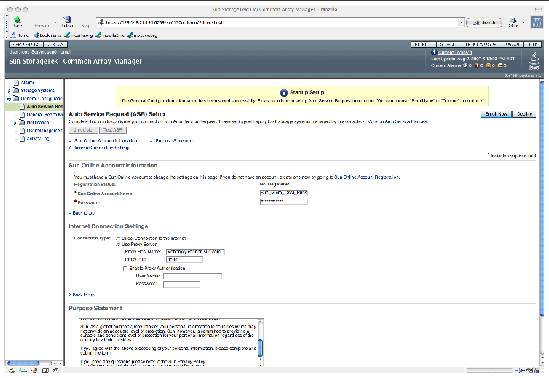
For more information on Auto Service Request, see Setting Up Auto Service Request.
After you register with ASR, you can choose which arrays you want to be monitored.
To register with the Auto Service Request service during the Common Array Manager installation, on the Auto Service Request Setup page:
1. Provide the following information:
2. Choose to accept or defer Auto Service Request.
a. To accept Auto Service Request, click OK.
b. To defer ASR service registration until later, click Decline.
There is a Test button to review that the ASR is set up correctly. You must register the array with ASR before using the Test button.
After you finish the defer ASR service registration, you can carry out the setup tasks described in the following sections, including registering arrays with this software, upgrading the array firmware, renaming arrays, setting the array password, setting the system time, and adding new users.
If you need help navigating the software or the online help, refer to Using the Browser Interface.
| Note - By default, the arrays are managed out-of-band over Ethernet. You can install in-band management, over the data path. To install in-band management, see Configuring In-Band Management. |
When you install the management software on a new workstation, the Storage System Summary page is displayed blank with no arrays listed.
On all subsequent logins to the Common Array Manager, the Storage System Summary page is displayed with the arrays you registered with the software.
To register an array, select Storage Systems in the left navigation pane and on the Storage Summary page, click Register. The Array Registration wizard starts and you can choose to either search the subnet for arrays that are not already registered or manually register an array.
Registering arrays are documented in the following sections:
The registration wizard will automatically discover arrays that are on the same subnet as the management host, or you can point the wizard to the array if it is not on the same subnet as the management host.
If searching for arrays on a subnet, the discovery process displays the percentage of completion while the array management software polls devices in the network to determine whether any new arrays are available. When complete, a list of discovered arrays is displayed.
The Storage System Summary page is displayed.
The Register Storage System wizard is displayed.
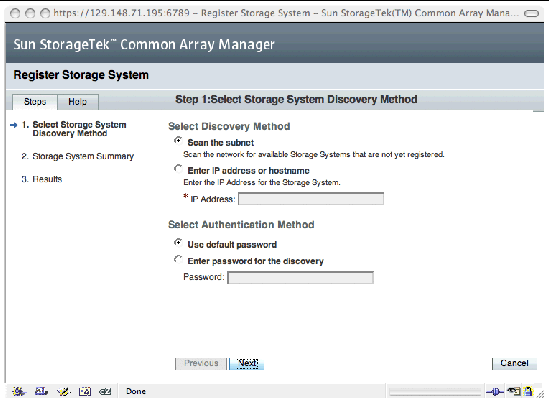
3. In the Register Storage System wizard, select the storage system discovery method you want to use and click Next.
The management software will scan the subnet it is on for unregistered arrays, or you can specify a specific IP address for the array if the array is outside of the storage system subnet. Additionally, you can have it use the default password for arrays or you can enter a password if you have already changed the password on the array.
| Note - The password of the array is not a required entry. The array is shipped with a blank password by default. This field is used only if the array being registered is one that was previously managed and had a set password. To give the array a password, see Setting an Array Password. |
With the scanning discovery method, the wizard then finds the array you defined and any unregistered arrays on the subnet and adds them to the Storage System Summary page.
| Note - It takes approximately 2 minutes for the software to discover each array. |
The Results page displays, showing whether the array was successfully registered with the software.
The Results page also displays a message if your firmware is not at the baseline to match this version of Common Array Manager software. To install the baseline firmware, see Installing the Baseline Firmware.
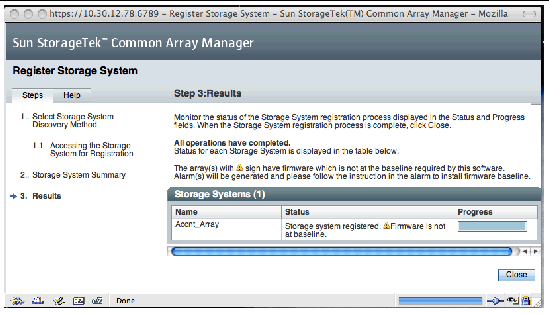
You remove an array from the management software by unregistering the array.
The Storage System Summary page is displayed.
2. Select the check box to the left of the array you want to remove from the list of registered arrays.
This enables the Remove button.
The array is unregistered and removed from the Storage System Summary.
The firmware for this release requires special instructions.
Refer to the Sun StorageTek Common Array Manager Software Release Notes, Release 6.1 or later for the latest firmware information and a list of firmware files for your array.
http://docs.sun.com/app/docs/coll/cam6.1
In addition to supplying the latest 06 level firmware for all arrays, this release supports new 7.10.x.xx firmware for the 6140, 6540, and FLX380 arrays.
| Note - The 7.10.x.xx firmware must be installed by Sun Service. |
The 7.10.x.xx firmware is not used by the 6130, FL240, FL280, and 2500 Series arrays.
For this release, the software will tell you if the array needs to install 06 baseline firmware. You can install that yourself with the procedure that follows.
Contact Sun Service to install 07.10.x.xx firmware. Once 7.10.x.xx is installed by Service, you can install future changes to the 07 baseline firmware yourself.
The following instructions apply to 06 level firmware and post-7.10.x.xx firmware.
You can update your array firmware by clicking the Install Baseline Firmware button on the Storage System Summary page or the array’s Administration page.
As part of the installation of the Common Array Manager software, the script puts the array firmware files in a directory on the management host. When you upgrade the firmware, the software analyzes the firmware installed on the array. If the baseline firmware on the host is newer, and you choose to install, the software installs the baseline firmware on the array.
For optimal performance, Sun Microsystems recommends that the firmware on all arrays be at the level of the current firmware baseline. New features are not supported with non-baseline firmware.
Always check the latest Common Array Manager and array Release Notes for the latest release-specific information about firmware and other features.
1. Check alarms and resolve the problems using Service Adviser before attempting to update.
2. On the Storage System Summary page, click the checkbox of the array you want to upgrade.
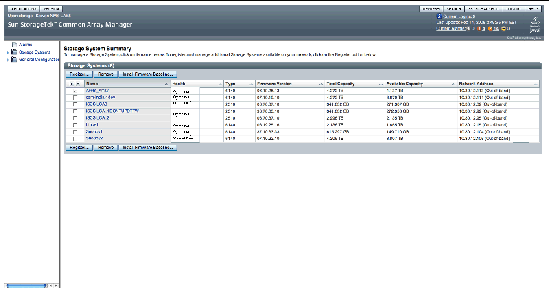
The Install Firmware Baseline button is enabled.
3. Click Array Firmware Baseline.
The management software launches the Analyze and Install Array Firmware Baseline wizard. Step 1, the Overview, is displayed.
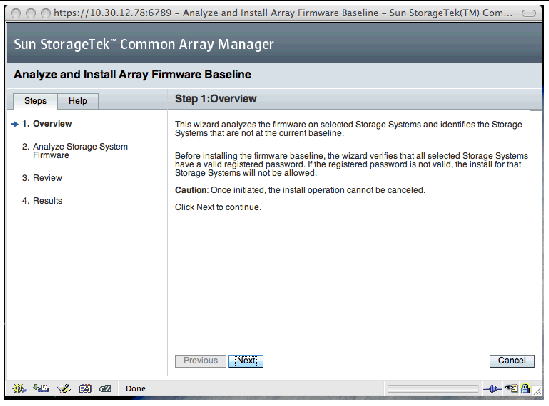
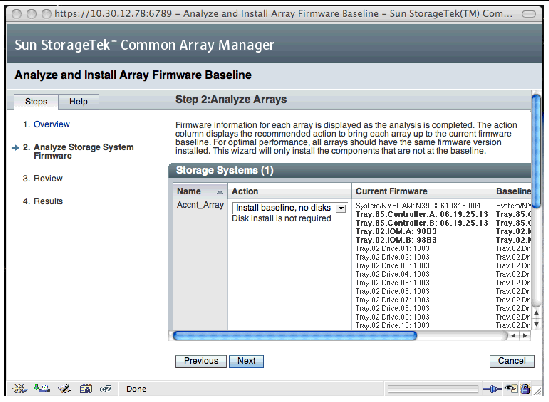
Step 2, Analyze Arrays, is displayed. It compares the current firmware to the baseline firmware. You set whether to install or not install the firmware baseline. Depending on the difference from the baseline, you may also set what type of firmware files to install.
5. If you need to update disk drive firmware, stop disk I/O before installation.
There is no need to stop I/O for installing controller, NVSRAM, and expansion module (IOM) firmware.
6. In the Action field, specify the type of upgrade, and click Next.
Step 2.1, Validate Password verifies that the array password is correct.
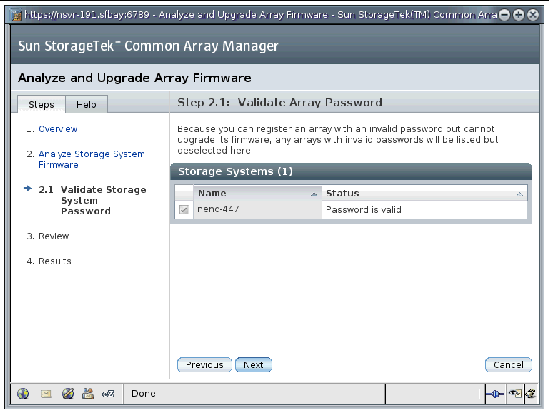

8. Review the current installation action.
9. To install the firmware, click Finish.
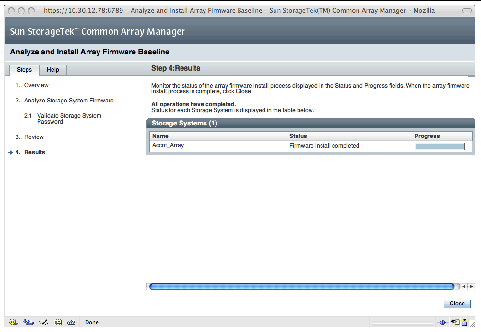
10. When the upgrade is complete, click Close.
If you have a need to back out of a firmware upgrade, contact Service.
To set up the array for basic operation, perform the procedures outlined in the following sections:
The Administration page contains other features that you may decide to configure. See the online help for more information before you change any default settings.
Open the Administration page to perform array administration functions.
1. In the navigation pane, click on the array you want to work with to expand the navigation tree.
The navigation tree expands to display the configuration options for the selected array, including Administration.
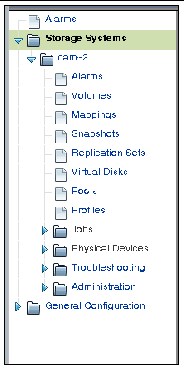
2. Click on Administration, under the array you have selected.
The Administration page for that array is displayed.
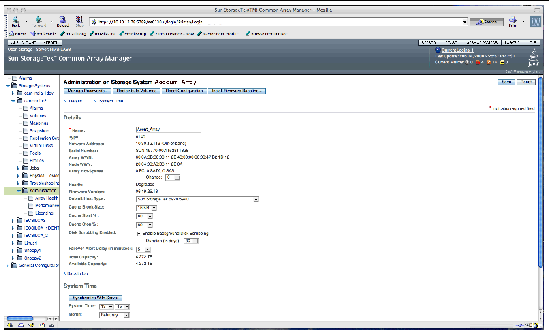
After making any changes on the Administration page, click Save to save the changes.
A new Sun StorageTek array is shipped with a blank, or empty, password field. Sun recommends that you establish an array password during initial setup for security purposes. The password prevents other management hosts from unauthorized access to the configuration of the array.
1. On the Administration page, click Manage Passwords.
The Manage Passwords page is displayed.
2. Select Change Array Password.
3. Leave the Old Password field blank.
This is the only time you can leave this field blank, when you establish a password for a new array.
4. Enter a new password consisting of up to 30 characters for the array.
5. Enter the password again to confirm the new password.
The Administration page is redisplayed.
The management software stores an encrypted copy of the array password, known as the local password, on the management host
Each array requires a unique name to be identified on the subnet.
In the Name field on the Administration page, enter a unique name consisting of up to 30 characters.
Hot spare drives are used by a controller to replace a disk that has failed. It is a good practice to define a hot spare before initiating storage on the array.
From the drop-down menu on the Administration page, select a drive to serve as a hot spare drive to provide alternative drive space in case of a failure. Refer to the online help for information about this and other advanced configuration features.
You can also update the system time and date on the Administration page for the array in the browser interface. When you set the time and date for a selected array, the values are updated for all arrays registered with this management software.
There are two ways in which you can update the system time and date:
1. On the Administration page, scroll down to the System Time section.
2. Select the current hour and minute according to a 24-hour clock.
3. If the date is incorrect, change the month, day, and year to the current date.
4. Click Save to save your changes.
The Administration page is refreshed, and a Success message is displayed at the top of the page.
For more information about the fields and buttons on the Administration page that you can use after you set up your system, see the online help.
The fault management features of the Sun StorageTek Common Array Manager software enables you to monitor and diagnose your arrays and storage environment. Alarm notification can be provided by:
You can also set up Auto Service Request as described in Setting Up Auto Service Request.
1. In the navigation pane, under General Configuration, choose Notification.
The Notification Setup page is displayed:
FIGURE 3-1 Email Fault Notification Setup

a. Enter the name of the SMTP server.
If the host running this software has the sendmail daemon running, you can accept the default server, localhost, or the name of this host in the required field.
b. Specify the other optional parameters, as desired.
c. If you have changed or entered any parameters, click Save.
d. (Optional) Click Test Local Email to test your local email setup by sending a test email.
If you need help on any of the fields, click the Help button.
3. Set up local email notification recipients.
a. Click Administration > Notification > Email.
The Email Notification page is displayed.
The Add Email Notification page is displayed.
c. Enter an email address for local notification. At least one address is required to begin monitoring events. You can customize emails to specific severity, event type, or product type.
4. (Optional) Set up remote notifications by SNMP traps to an enterprise management application.
a. Select SNMP as the provider.
5. Perform optional fault management setup tasks:
To set up the array for basic operation, perform the procedures outlined in the following sections:
The first time that you access your array software, you sign on as an administrator:
You then assign a user role of storage or guest to each user of the software. The storage role allows a user access to all of the software features related to storage device configuration and array management.
The storage and guest roles must be added to the management host using its OS software. For Solaris OS, consult system administration documentation. For Windows, add groups for storage and guest and assign members to those groups. Refer to Adding User Roles and New Users to Windows for additional information about adding roles in Windows.
The user role assigned to a user determines that user’s access to the management functions for the array. TABLE 3-1 describes the valid user names and user role functions and the requirements for each.
1. Setting up with an administrative role.
In Solaris or Linux, by default, root has a storage role that allows full privileges. Before you can add other user and assign that user a user role, the user name must be defined in the Linux or Solaris Operating System /etc/passwd file or network information server (NIS).
In Windows, you can set up an administrative role with full privileges. You can even call it root, as noted in Adding User Roles and New Users to Windows.
2. Restrict use of the administrator role.
To maintain security on the server running the management host software, the root or administrator user name and password should be used only the first time you log in. At that time, create at least one user with a storage user role. Thereafter, that created user can perform all available management functions, including adding or modifying users.
3. Make rules for multiple users with storage roles.
Multiple instances of the same user name can be logged in concurrently. However, because users with the storage user role have write privileges, there is a risk that the changes of one logged-in user will overwrite previous changes of another logged-in user. Therefore, you should develop policies about who can make changes and how to notify others.
This section describes how to add new users in Solaris or Linux.
1. To view the list of defined users, choose General Configuration > User Management in the navigation pane.
The User Summary page is displayed.
2. To add a new user, click the Add button.
The Add New User page is displayed.

3. In the User Name field, enter a valid user name.
The user name must be defined in the /etc/passwd file or NIS.
4. From the User Role list, select the role you want to assign for this user.
You can assign a user to one of the user roles identified in TABLE 3-1.
The User Summary page is displayed with a success message, and the name is added to the list.
| Note - Newly added users should enter the same password for the Sun Java Web Console that they use in their Linux or Solaris accounts. |
This section provides the information you need to create users in Windows and assign them to groups for privileges. The created users can sign into the Java Web Console to access the Sun StorageTek Common Array Manager software.
This appendix contains the following section:
When you first log into the Java Web Console Sun StorageTek Common Array Manager software requires that the user have Windows administrative privileges.
These instructions show you an example of how to configure an administrative user in standard Windows XP. Other versions of Windows software may vary slightly. Consult the Windows documentation.
| Note - Administrative user names for Windows cannot have a space character. |
This example sets up a root user with Windows administrator privileges. Normally root is a role associated with Unix. By using the root user concept with Windows you can have a common storage administrator’s role across platforms.
1. Click Start and select Administrative Tools -> Computer Management.
The Computer Management window displays.
2. In the Computer Management window, select Local Users and Groups -> Users.

3. Right click and select New User.

4. Complete the New User window as follows:
a. Enter root in the User name box.
b. Create a password and confirm it.
c. Uncheck the box labeled User must change password at next login.
d. Check Password never expires.
The Computer Management window displays.
f. Select Users, right click on root, and select Properties.
The Root Properties window displays.

The Select Groups window displays.
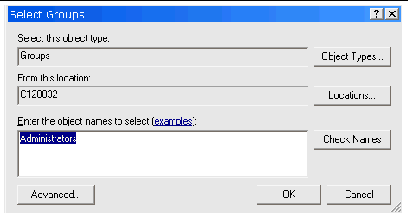
7. In the Enter the object names box, type Administrators and click Check Names.
The system displays the computer-name\Administrator group in the box labeled “Enter the object names to select.”
The root Properties window shows that root is a member of the Users and Administrators groups. The root user now has Windows Administrator privileges.
You will need a storage user and other users in Windows. To set up subsequent users, follow the same steps as Adding a Administrator User, but substitute a user name for root and storage for the Administrator role.
When done, check the user Properties window and Member of tab to verify that the user is assigned to the Users and storage groups.
During the initial storage array registration process, Common Array Manager prompts you to register with the Auto Service Request service by displaying the Auto Service Request (ASR) Setup page. This page continues to display until you either fill out the page and click OK, or click Decline to either decline or defer ASR service registration.
To set up the array for Auto Service Request, perform the procedures outlined in the following sections:
Auto Service Request (ASR) monitors the array system health and performance and automatically notifies the Sun Technical Support Center when critical events occur. Critical alarms generate an Auto Service Request case. The notifications enable Sun Service to respond faster and more accurately to critical on-site issues.
The Common Array Manager provides the interface to activate Auto Service Request on behalf of the devices it manages. It also provides the fault telemetry to notify the Sun service database of fault events on those devices.
To use ASR, you must provide account information to register devices to participate in the ASR service. After you register with ASR, you can choose which arrays you want to be monitored and enable them individually.
ASR uses SSL security and leverages Sun online account credentials to authenticate transactions. The service levels are based on contract level and response times of the connected devices.
ASR is available to all customers with current StorageTek Warranty or StorageTek Spectrum Contracts. The service runs continuously from activation until the end of the warranty or contract period
Only the event information listed in the following table is collected.
Your stored data is not read and remains secure.
The event information is sent by secure connection to
https://cns-services.sun.com.
During the initial storage array registration process, the Common Array Manager prompts you to register with the Auto Service Request service by displaying the Auto Service Request (ASR) Setup page. This page continues to display until you either fill out the page and click OK, or click Decline to either decline or defer ASR service registration.
After you register with ASR, you can choose which arrays you want to be monitored.
To register with the Auto Service Request service:
1. Click Sun StorageTek Common Array Manager.
The navigation pane and the Storage System Summary page are displayed.
2. In the navigation pane, expand General Configuration and choose Auto Service Request.
The Auto Service Request Setup page displays.
3. Provide the following information:
You can test the Auto Service Request service connection to ensure that communication between the email address specified on the General Configuration page and Sun Online Account services is successful. The array must be registered with the Auto Service Request service before testing.
To test the Auto Service Request registration:
1. Click Sun StorageTek Common Array Manager.
The navigation pane and the Storage System Summary page are displayed.
2. In the navigation pane, expand General Configuration and choose Auto Service Request.
The Auto Service Request Setup page displays.
The Sun Online Account service will send a confirmation email to the email address on record for your Sun Online Account, which is specified on the General Configuration page. If you do not receive a confirmation email within approximately 30 minutes, contact the Sun Online Account personnel.
When you unregister from Auto Service Request service, ASR will stop monitoring array health for your system.
To unregister from the Auto Service Request service:
1. Click Sun StorageTek Common Array Manager.
The navigation pane and the Storage System Summary page are displayed.
2. In the navigation pane, expand General Configuration and choose Auto Service Request.
The Auto Service Request Setup page displays.
After registering with ASR, you can choose which arrays to monitor using ASR. In order for an array to be monitored using ASR, the following settings must be in effect:
While ASR is enabled by default, the following settings must be configured to use ASR to monitor an array:
1. Click Sun StorageTek Common Array Manager.
The navigation pane and the Storage System Summary page are displayed.
2. In the navigation pane, expand the array you want to monitor using ASR.
3. In the navigation pane, expand Administration and click on Array Health Monitoring
The Array Health Monitoring Setup page is displayed.
4. In the Health Monitoring section, ensure that the Health Monitoring Agent Active and the Device Category Monitored fields are set to Yes. If either are set to No, go to the General Health Monitoring Setup page and change the settings.
5. In the Monitoring this Array section, select the checkbox next to both Health Monitoring and Auto Service Request.
By default, the management host communicates with the arrays out-of-band over Ethernet. You can also configure in-band management for communication to travel over the data path (using Fibre Channel (FC), etc.) between a data host and the array.
Setting up the array for in-band management is outlined in the following sections:
In-band management uses a proxy agent running on a data host to communicate with a managed array. Sun StorageTek Common Array Manager software discovers the proxy agents on the subnet and then queries arrays registered with the software. The proxy agent receives the queries over Ethernet and passes them on to the array over the data path between the data host and the array.
New arrays can be registered with the software using the registration wizard. The wizard can auto-discover the array via the proxies or you can specify the IP address of the proxy agent. Once an array is registered, management of the array appears the same as does management with an out-of-band connection. Volume creation, deletion, and mapping are accomplished in the same manner.
In-band management uses a special access LUN mapping to facilitate communications between the management software and the storage array. You can view all mappings on the array on the Mapping Summary Page in the Sun StorageTek Common Array Manager software. For in-band communication, an access volume is mapped to LUN 31. This special access LUN (also called the UTM LUN) is mapped to the default domain. (All arrays have a default domain for volumes not registered with a storage domain.)
With new arrays, the mapping of the access LUN to the default domain is installed at the factory. If you lose this mapping, before installing in-band, use out-of-band management and the Common Array Manager software to re-map the access LUN to the default domain. See the online help in the software for more information about mapping.
This release supports Solaris Sparc and x86, Windows, and Linux for in-band management. For Red Hat Enterprise Linux AS, Release 5.1 or higher is required. Check the Sun StorageTek Common Array Manager Release Notes, v.6.1 for the latest list of packages to install from the CD.
|
1. Connect two in-band (FC, etc.) cables between HBAs on the data host where the proxy is to be installed and the array (one cable to each controller).
2. Install the SMruntime and SMagent packages on the proxy host, using the pkgadd command in Solaris and rpm command in Linux.
pkgadd -d <directory or disk-directory> SMruntime-SOL-xx.xx.xx.xx.pkg pkgadd -d <directory or disk-directory> SMagent-SOL-xx.xx.xx.xx.pkg
rpm -ivh SMruntime.xx.xx.xx.xx-xxxx.rpm rpm -ivh SMagent-LINUX-xx.xx.xx.xx-xxxx.rpm
3. Solaris only - to verify that the host sees the access LUN to manage the array via the in-band path, perform the following commands on the data host:
setenv LD_LIBRARY_PATH /opt/SMgr/agent java -classpath /opt/SMgr/agent/SMagent.jar devmgr.versioned.agent.DeviceIdentifier | grep "Volume Access"
The arrays with access LUNs visible to the agent will display as follows:
/dev/rdsk/c5t200600A0B82458D4d31s2 [Storage Array fms-lca1, Volume Access, LUN 31, Volume ID <600a0b80002458d20000000000000000>] /dev/rdsk/c5t200700A0B82458D3d31s2 [Storage Array fms-lca1, Volume Access, LUN 31, Volume ID <600a0b80002fc0740000000000000000>]
4. Verify that the Proxy Agent is running. If necessary, check the SMagent process and restart in /opt/SMgr/agent/SMagent.
5. To start the agent, perform this command in Solaris or its equivalent: /opt/SMgr/agent/SMagent start
If the agent was running, it will stop and then restart after a status check.
# ps -ef | grep SMagent | grep -v grep /opt/SMgr/agent/jre/bin/java -classpath /opt/SMgr/agent/SMagent.jar devmgr.launch
Sign in to the software and begin configuring as listed in Starting the Management Software. After the registration process discovers arrays, they display on the Storage System Summary page. The Network Address field displays whether the connection with each array is in-band or out-of-band. The Common Array Manager software can manage arrays with either in-band and out-of-band connections at the same time.
If you are going to copy a configuration file to a management host that will have in-band communication with the array, you need to preserve the mapping between the access LUN and the management host using the import array command with the -n (noclear) option.
import -x <XML-location> [ -L <list> ] [ -n ] array <array-name>
The import command typically applies an array configuration file to the specified array. The -n option preserves the current array configuration, including the mapping between the access LUN (LUN 31) and the default domain of the management host. This mapping is required for in-band management of the array.
-x,--xml <XML-location>
Specifies the location of the XML file to be imported. The XML location can be in the form of a URL (http://... or file:///...) or a file name.
-L,--list
Specifies that no import take place. Instead, the array is checked against the XML file to ensure that it is compatible.
-n,--noclear
Specifies that the current array configuration will not be cleared.
array <array-name>
Specifies the array to which the configuration file is applied.
You are now ready to review the planning concepts that will help you to configure storage. If you are familiar with the concepts, you can proceed to Configuring Basic Storage.
Copyright © 2008, Sun Microsystems, Inc. All Rights Reserved.